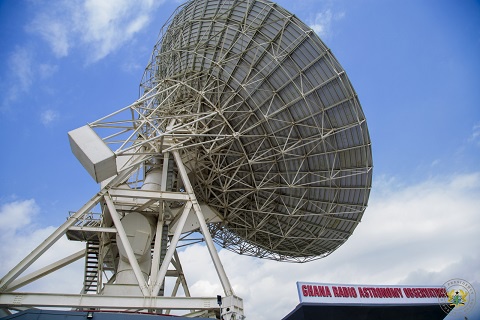President Nana Addo Dankwa Akufo-Addo on Thursday launched the Ghana Radio Astronomy Observatory at Kuntunse, a development set to put Ghana on the pedestal of countries that are into space science.
The President said that the progress marked the beginning of a new era in Ghana’s quest to harness the potentials of Space Science and Technology for accelerated socio-economic development.
This development makes Ghana the second country in Africa to own such facility after South Africa.
The President said the new era would not only witness the deepening of knowledge and skills development in electronics and information and communications technology, but also enhance the capacity of scientists to contribute to the world body of knowledge in the ever expanding field of astronomy and space science.
At a short ceremony before cutting the tape to officially open the observatory at the lush foothills of Kuntunse, President Akufo-Addo recounted how, in 2007, the country, under the leadership of President John Agyekum Kufuor, took the bold decision to sign up to the African Square Kilometre Array (SKA) partnership agreement, spearheaded by South Africa, which involved seven other African countries.
This decision, he explained, was made at the time when Ghana did not have any programme in astronomy, and was an example of the bold and visionary leadership of the time.
Its purpose is to propel the country to the enviable league of countries pursuing space science.
Ghana, by this feat, has become the first partner country of the African Very Long Baseline Interferometer Network to complete the conversion of the 32-metre Intelsat Telecommunications Satellite Earth Station at Kuntunse into a functioning radio telescope.
A second phase of the 32-meter antenna involving more engineering work would be carried out to help increase the sensitivity and speed of the dish from 0.09 degrees per second to 0.3 degree per seconds.
The first phase of the observatory involved the structural work of the antenna, electrical works and the total configuration, which used to be a redundant telecommunications dish belonging to Vodafone Ghana that used to point only to one direction.
President Akufo-Addo expressed the hope that the “integration of this radio telescope into the African Very Long Baseline Interferometer Network, in preparation for the second phase construction of the Square Kilometre Array across the African continent, will be successful.”
He said the recent successful launch into orbit of GhanaSat-1, a satellite developed by three students from All Nations University College in Koforidua, in partnership with their Japanese counterparts at Kyushu Institute of Technology, indicated that Ghana abounded in talent, expressing Government’s pleasure to see Ghanaian talents shining, with even greater promise for the future.
The President reiterated the commitment of Government to continue to develop the human capital needed for a sustainable implementation of the country’s space programmes, particularly enhancing the nation’s human resource capacity in astronomy research.
“We have big plans for our national space development programme. These include the establishment of a National Space Data Centre for satellite data collection, management and application. This comprehensive programme will involve the establishment of a national satellite ground receiving station and the launch of satellites,” he said.
“The radio telescope, being launched today, will expand further our frontiers in space science. I am informed that the radio telescope will provide information from distant bodies in the universe that will help us understand the birth and formation of stars, the death of stars and the general structure of the universe.”
President Akufo-Addo expressed optimism that the observatory would enable Ghanaians appreciate the reality and complexity of global warming and its harmful effects such as rising sea levels, coastal erosion, erratic rainfall patterns, prolonged and intense dry seasons, desertification and reduction of vegetation cover on their lives.

“It is for this reason that we, as humans and care-takers of our earth, should not compound the pressures on our fragile planet through harmful activities, such as illegal mining and logging and the production of greenhouse gases,” he added.
Recognising the role of science and technology in the socio-economic development of the country, President Akufo-Addo said he had charged the Ministry of Education, and Ministry of Environment, Science, Technology and Innovation to step up efforts in developing a potent science, technology, engineering and mathematics (STEM) education model for Ghana.
That, he said, would stimulate the interest of pupils and students in engineering sciences and technology.
With the establishment, shortly, of a Presidential Advisory Council on Science, Technology and Innovation (PACSTI), President Akufo-Addo reiterated his pledge of raising, significantly, funding for Research and Development (R&D) in science, technology and innovation from 0.25 per cent to 1 per cent of GDP in the short to medium term, and increased further to 2.5 per cent in the long term.
“It will form the National Science, Technology and Innovation Fund to support R&D in all research Institutions and Universities, both public and private. At the same time, Government will make efforts to increase collaboration among research institutions, industry, especially the private sector, and political authorities at all levels.
“These measures, I hope, will make the transition from research to product development and industrial production much easier,” he added.
General News of Friday, 25 August 2017
Source: ghananewsagency.org

















